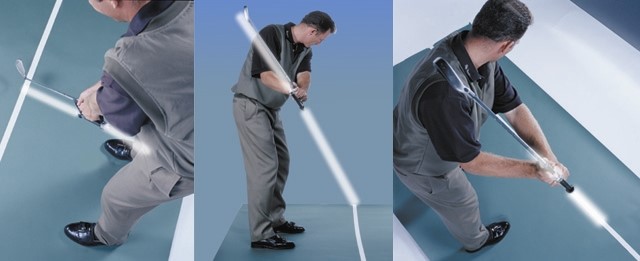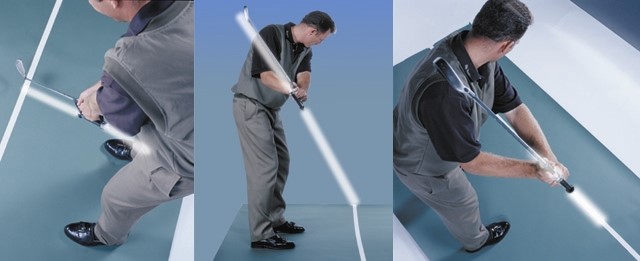Every golfer I know is looking for the “Secret”. Well, there’s good news and there’s bad news. The bad news first… there is no real secret! But, there is some good news… there is an easier way of improving your game and thus lowering your scores. There is no panacea, no gimmick that will work miracles, but with a little bit of effort on your part and a little help with your training, amazing results can be achieved.
The Route to Success
You see and hear them talk about it on TV. You constantly read about it in magazines and books. Golf instructors persistently preach it. I’m referring to the swing plane. According to the greatest teachers and players in history, it is the single most important element of the golf swing. The legendary Ben Hogan wrote in his book, The Fundamentals, “Staying on his plane as he swings back is a golfer’s best insurance of being in a correct and powerful position at that critical juncture where his backswing ends and the downswing begins.” In Golf Digest, Hank Haney adds, “The primary benefit of an on-plane swing is consistency, your ability to return the clubface at impact to the position it was at address.” Jim McLean devotes an entire chapter to the plane in his classic book, The Eight Step Swing. In his book Breaking 90, Johnny Miller once again emphasizes the swing plane.
The Swing Plane – What is it?
Virtually every significant golf instructor in the world accepts the concept of the “swing plane”. But what is the swing plane and what application does it have to the average golfer? The best definition I’ve seen was given by Gregor Jamieson, one of Golf Magazine’s 100 Top Teachers and Director of Golf at the Lake Nona Golf Club in Orlando. He writes,” I define the swing plane as the relationship between where the clubshaft is pointing and the target line. A golf swing is “on plane” if either the clubhead end or the grip end of the shaft points at (or close to) the target line throughout the entire swing.”
Consequently, it is easier to make square, solid contact with the ball, by staying “on plane”. Deviate from the plane, and conscious or unconscious compensations are necessary to “be square” at impact. According to Jim Flick, , “As a general rule, whichever end of the club is closest to the target line should be pointing to the target line or reasonably close. I call this keeping the club “in balance” with the target line. It’s critical in maintaining the proper swing arc. That would be easy enough to determine with a freeze-frame video of your hands stopped midway between your waist and the top of your backswing. You’d simply draw a straight line extending down from your shaft to the target line.” Unfortunately, we can’t work with video freeze frame while we swing.
Illuminating the Plane
Bob Toski, legendary PGA player and member of the World Golf Teacher’s Hall of Fame states, “I’ve been trying to teach my concept of the swing plane for fifty years, but words were never enough.” He made it quite clear that learning the “swing plane” is difficult for every golfer, young or old, good or bad, and this includes many professionals. So how can we see it? By lighting it up!
The concept of illuminating the swing plane has been around for years. You’ve probably seen numerous light or laser devices on the market recently. Over the years I have seen and tried just about every type device available and the best tool that I have seen is the original, the EZ Way Swing Trainer. Using the EZ Way Swing Trainer best illuminates that “map” to which Mr. Hogan referred. Now, immediate visual feedback is available. Powerful light beams extending from both ends of the shaft, trace and light up our swing path while we swing. Because this trainer has two beams, you can do just what Hogan refers to… see your swing path during the takeaway and downswing. That awareness, built into muscle memory through committed practice, will eventually permit the golfer to more consistently swing “on plane”. No more reinforcing incorrect movements. Using the swing trainer will assist in developing the proper “feel”.
The EZ Way Swing Trainer
This compact, lightweight unit emits powerful light beams from both ends. It connects to your club by taking a normal grip, nothing to attach. As I began swinging, it fit so comfortably, I was unaware of its presence. With my first swing, I was able to understand a concept my instructor had been trying to teach me for years. The beams gave me instant feedback, illuminating my incorrect path and plane and just as quickly the lights guided me down the correct line. It was amazing! Feedback and reinforcement are vital in learning any motor skill like the golf swing, and this product provides both.
The EZ Way Swing Trainer gives the golfer a visual reference point. What you see you can understand. What you understand, you can fix. Designed for indoor practice, without a ball to fret over, it helps develop the proper feel of a swing, as opposed to a hit. I can still hear Toski saying to me, “Finkel, if you ever want to learn how to play this game, you’ll have to learn to feel the swing.” Through repetition, I was able to develop the feeling of an on-plane swing in my muscle memory. I’ve tested other similar products before, but none were as effective. Being able to use your own clubs, putter through driver, is a significant benefit.
After I tested it, I wanted the opinion of a true expert, so I sent a unit to Bob Toski. After trying out this trainer, Toski, chosen as one of the “Top Ten” golf instructors of the 20th century by Golf World Magazine said, “No question about it, this will definitely help your swing. With this swing trainer, now you can see your actual swing plane.” That’s a serious endorsement from someone that really understands the golf swing. www.ezwaygolf.com


